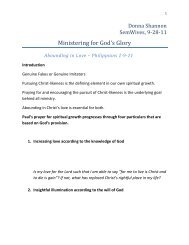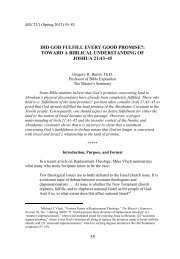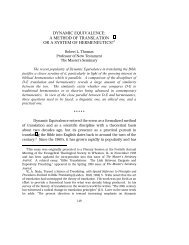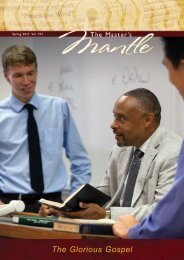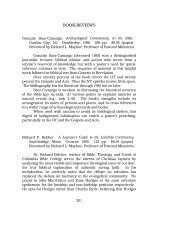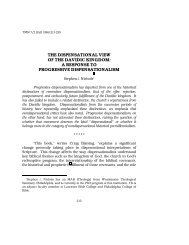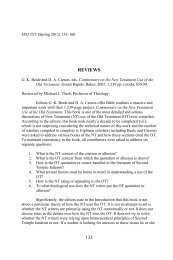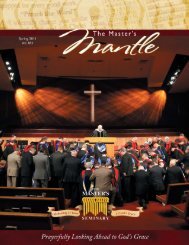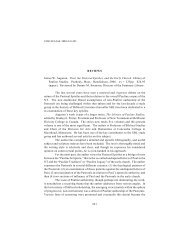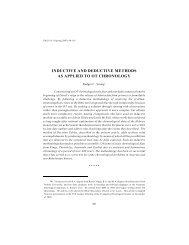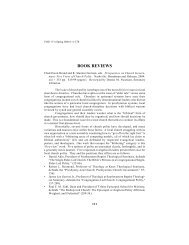You also want an ePaper? Increase the reach of your titles
YUMPU automatically turns print PDFs into web optimized ePapers that Google loves.
<strong>THE</strong> <strong>SIN</strong> <strong>UNTO</strong> <strong>DEATH</strong>Irvin A. BusenitzAssociate Dean and Professor of Old Testament<strong>The</strong> <strong>Master's</strong> <strong>Seminary</strong><strong>The</strong> "sin unto death" in 1 John 5:16 has provoked widespreaddiscussion. <strong>The</strong> correct meaning revolves around the nature of the sin and thenature of the death referred to. <strong>The</strong> context and word selection point to theconclusion that the individual "committing a sin not unto death" is an unsavedman who professes to be a believer, but who is, in actuality, in need ofsalvation. On the one hand, John refers to one who is sinning but is not doingso to the point of the impossibility of being granted eternal life. <strong>The</strong> apostleencourages intercessory prayer for such an individual, that God may grant tohim eternal life. On the other hand, he asserts that if a man does sin to suchan extent that repentance and forgiveness are impossible, it would be "untodeath," spiritual death in the sense that his condition is irrevocable (cf. Matt12:31-32).* * * * *Diversity of opinion has abounded concerning theinterpretation of the problematic portion found in 1 John 5:16 wherethe apostle John writes,If any one sees his brother committing a sin not leading to death, he shall askand God will for him give life to those who commit sin not leading to death.<strong>The</strong>re is a sin leading to death; I do not say that he should make request forthis. 1<strong>The</strong> OT frequently mentions specific sins which meritpunishment by death. Num 15:30-31 indicates that the one whowillfully and defiantly sins "shall be cut off from among his people."<strong>The</strong> sin of coming near to the tent of meeting was punishable by death(Num 18:22). Ps 19:13 suggests the same penalty for presumptuous1Scripture quotations in this essay are taken from the New American StandardBible unless otherwise noted. "Sin unto death" in the essay title and used frequentlythroughout the essay is phraseology derived from 1 John 5:16 in the King JamesVersion.17
sins. 2<strong>The</strong> NT has similar examples, the most prominent being that ofAnanias and Sapphira (Acts 5:1-10). Other examples include that ofHerod (Acts 12) and those who had taken the Lord's Supperunworthily (1 Cor 11).<strong>The</strong>re are two notable differences between the other passagesand this one, however. First of all, in the above cases, the sin which ledto the punishment is more or less evident; in this instance, it is notrevealed. Secondly, the exact nature of the death penalty is ambiguoushere, while elsewhere it is not. So the problem encountered here isunique.Two basic questions call for a response in this passage: (1)What is the nature of the sin? And (2) What is the nature of the death?<strong>The</strong> answers to these will essentially answer a third, namely, can thesin be committed today by Christians?<strong>THE</strong> CONTEXT2 Also cf. Lev 4:2; 5:15; Num 14:2-4; 20:12; and 1 Sam 2:25. This same philosophywas continued in the Qumran Community, as the Manual of Discipline givesevidence (1QS 8:21-9:2). During the first centuries A.D., this concept was taken evenfurther: "Tertullian went a stage further and listed the grosser sins (includingmurder, adultery, blasphemy and idolatry) as beyond pardon" (John R. W. Stott, <strong>The</strong>Epistles of John [Tyndale's New Testament Commentaries, ed. by R. V. G. Tasker;Grand Rapids: Eerdmans, 1976] 187).18
<strong>The</strong> Sin Unto Death 19<strong>The</strong> entirety of 1 John deals with tests of life, tests designed togive assurance of salvation to believers (cp. 5:13 with 1:4; 2:12-14) andto expose those who are not really believers: "We shall know by thisthat we are of the truth, and shall assure our heart before Him" (1 John3:19). 3 <strong>The</strong> fact that one is or is not a believer is not always obvious;rather, continuation in the truth is a test which will ultimately reflectthe validity of the profession. 4In the preceding verses (5:14-15), John speaks about prayer andthe confidence a believer may have concerning the acceptance of thatprayer before God and the granting of the request. In verses 16-17, hegives a specific illustration and limitation within which the prayer of aChristian may be benevolently and effectually employed, namely, inrescuing a brother from death.It is not now a case of petition, but of intercession. <strong>The</strong> assurance of eternal lifewhich the Christian should enjoy (13) ought not to lead him into preoccupationwith himself to the neglect of others. On the contrary, he will recognize his dutyin love to care for his brother in need. . . . <strong>The</strong> future tense he shall askexpresses not the writer's command but the Christian's inevitable andspontaneous reaction. 5Thus it is that when one comes to the throne of God in prayer,the standing of his brother is immediately brought into focus. Thisconnection has led Cameron to remark, "Our holiest hours of prayerand worship should be marked by benevolence toward our brethren." 6<strong>THE</strong> NATURE OF <strong>THE</strong> <strong>SIN</strong>Various attempts in satisfactorily resolving the difficultiesregarding the character of the sin have been made. Some of the manyinterpretations include: (1) the sin against the Holy Spirit, (2) any great3 See Robert Law, <strong>The</strong> Tests of Life (Edinburgh: T. & T. Clark, 1914).4 Cf. 1 John 2:19 where some who professed Christ and were a part of the localbody of believers were ultimately exposed by their departure.5 Stott, Epistles 186.6 Robert Cameron, <strong>The</strong> First Epistle of John (Philadelphia: A. J. Rowland, 1899) 242.
20 <strong>The</strong> <strong>Master's</strong> <strong>Seminary</strong> Journalsin, such as murder or adultery, (3) rejection of Christ as Messiah, (4)deliberate and willful sins, (5) apostasy, and (6) post-baptismal sins. 7<strong>The</strong> most significant of these will be examined.Mortal sins<strong>The</strong> Church of Rome has consistently maintained that the "sinunto death" is a grave, post-baptismal sin. 8 This sin is commonlyreferred to as "mortal" sin, as compared with the less significant sinwhich is called "venial." Although the designations are not specificallynamed in Scripture, it is asserted that the distinction between the twotypes of sin is clearly affirmed. In general, mortal sins are said to bethose which exclude the offender from the kingdom (e.g., Eph 5:5; Gal5:19-21) and venial sins are those which do not (e.g., James 3:2; 1 John1:8; Eccl 7:21). 9 Additional proof for such distinctions is given by Dens,as quoted by M'Clintock and Strong:"It is, moreover, certain," says Dens, "not only from the divine compassion, butfrom the nature of the thing, that there are venial sins, or such light ones, as injust men may consist with a state of grace and friendship with God; implyingthat there is a certain kind of sin of which a man may be guilty withoutoffending God." 10A more specific basis for these definitions is provided byAquinas. Describing the distinctiveness of the two types, he explains,<strong>The</strong> difference between venial and mortal sin follows upon a diversity of7 A list of additional interpretations is given by Barnes, "<strong>The</strong> First Epistle Generalof John," Barnes' Notes on the New Testament Testament, X (Grand Rapids: Baker,1975[rpt.]) 348-49, and Raymond E. Brown, <strong>The</strong> Epistles of John (vol. 30 of <strong>The</strong> AnchorBible; Garden City, NY: Doubleday, 1982) 611-620.8 Deadly sins committed prior to the time of baptism are said to be cleansed at thetime of that sacrament (James Gibbons, Faith of Our Fathers [Baltimore: John Murphy,1905] 303 ff.). For this reason many have waited until their deathbed to be baptized.9 I. McGuiness, "Sin (<strong>The</strong>ology of)," <strong>The</strong> Catholic Encyclopedia, XIII (New York:McGraw-Hill, 1967) 245.10 John M'Clintock and James Strong, "Sin," Cyclopaedia of Biblical, <strong>The</strong>o-logical, andEcclesiastical Literature, IX (Grand Rapids: Baker, 1969[rpt.]) 767.
<strong>The</strong> Sin Unto Death 21disorder inherent in the concept of sin itself. This disorder is twofold: the oneinvolves the abandonment of the very source of order, the other only involvesdeparture from secondary elements in that order. . . . Hence, when the soul is sodisordered by sin that it turns away from its ultimate goal, God, to whom it isunited by charity, then we speak of mortal sin. However, when this disorderstops short of turning away from God, then the sin is venial. 11Venial sins, therefore, do not make one the offender of God;they do not cause a diminution of sanctifying grace. Though theyconstitute a violation of God's law, they are too small and insignificantto divert one from his ultimate goal, God. Mortal sin, on the otherhand, constitutes an act in which the offender deliberately chooses"some created good as a final end in preference to the Supreme Good,with a consequent loss of sanctifying grace." 12<strong>The</strong> NT does teach that sins differ in magnitude (cf. Matt 10:15;11:22, 24; Luke 10:12, 14; 12:47, 48). Nevertheless, holding such aninterpretation as set forth by the Roman Church entails several difficulties.First, the definition of venial and mortal is imprecise,essentially destroying any real distinction between the two. Becausetheir general definition of sin specifically states that "sin is a deliberateand voluntary act, . . . an act marked by a want of conformity with thelaw of God," 13 they are forced to make some fine differentiations andto conclude that venial sin is "imperfectly deliberate" while mortal sinis "fully deliberate." 14 Such terminology makes a distinction virtuallyimper-ceptible. Furthermore, the definition is untenable in light ofcertain scriptural examples. Paul persecuted the first centuryChristians in ignorance (1 Tim 1:13), yet he designates himself as thechief of sinners (1 Tim 1:15). Eve was deceived by Satan (1 Tim 2:14)but bore the consequences of mortal sin.Secondly, Scripture teaches that every offense is deadly and11 Thomas Aquinas, Summa <strong>The</strong>ologiae (XXV, trans. by Timothy McDermott; NewYork: McGraw-Hill Book Company, 1969) 43.12 McGuiness, "Sin" 241.13 Ibid.14 Ibid.
22 <strong>The</strong> <strong>Master's</strong> <strong>Seminary</strong> Journalsubject to the claims of divine justice. Thus Ezek 18:20 declares, "<strong>The</strong>person who sins will die." Likewise Rom 6:23 asserts, "<strong>The</strong> wages ofsin is death." <strong>The</strong> malicious motivation behind the sin, or the lack of it,makes no difference, as James 2:10 indicates: "For whoever keeps thewhole law and yet stumbles in one point, he has become guilty of all."On the other hand, the Bible explicitly and implicitly declares that nosin is too great to be beyond the scope of God's forgiveness (cf. 1 Tim1:15).Thirdly, that the kind of sin does not determine whether itspunishment is temporal or eternal but merely results in greater orlesser punishments is illustrated by the appointed sacrifices of the OT.Different sins demanded different sacrifices; nevertheless, "without theshedding of blood there was no remission" (cf. Heb 9:22). Though sinsdiffer in degree, the essential character of sin does not vary.<strong>The</strong> classification of sins as adumbrated by the Roman CatholicChurch has no basis in Scripture, neither in 1 John nor elsewhere. <strong>The</strong>NT gives no precedent for such a practice nor does it warrant such anarbitrary conclusion.
<strong>The</strong> Sin Unto Death 23ApostasySome authors have suggested that the "sin unto death" refers tototal apostasy, exemplified by the renunciation of the faith. Brooke, aproponent of the view, maintains that the sin is a deliberate rejection ofChrist and His claims, for such "was probably the most prominent inthe writer's thought." 15 That this is so, it is contended, is evident from1 John 2:18-19 where the false teachers are reported to have left thefellowship of believers. 16Brooke further explains that since apostasy exhibits itself apartfrom any specific act of sin, this conclusion dovetails with the fact thatno specific sins are mentioned here. He concludes that "in the author'sview any sin which involves a deliberate rejection of the claims ofChrist may be described as `unto death.'" 17 Lenski concurs with thisassessment:Since zv (z) "life eternal" (v. 13), which, as we now "have" it, is spiritual,"death" must be its opposite, namely the loss of spiritual life, which is spiritualdeath. Once having been born from God (2:29; 3:9; 4:7; 5:4, 18) into the newlife, "death" means that this life has been lost. 18<strong>The</strong> major difficulty with this conclusion, however, is the factthat Scripture nowhere teaches that the genuinely regenerated personcan apostatize. This same writer in his Gospel contends that thebeliever is secure (John 10:28, 29). Elsewhere in this Epistle, he15 A. E. Brooke, A Critical and Exegetical Commentary on the Johannine Epistles (in theInternational Critical Commentary, ed. by C. A. Briggs, et. al.; Edinburgh: T. & T.Clark, 1971) 147. Marvin Vincent appears to embrace this view also, for he states that"whatever breaks fellowship between the soul and Christ . . . is unto death for there isno life apart from Christ" (Word Studies [Vol. II; New York: Charles Scribner's Sons,1911] 371).16 Heb 6:4-6; 10:26-29 are usually associated with this view and are frequentlyemployed as proof of its veracity.17 Brooke, pp. 146-47. Lenski agrees, stating that this sin results in "the loss ofspiritual life, which is spiritual death" (R. C. H. Lenski, <strong>The</strong> Interpretation of St. Peter,St. John, and St. Jude [Minneapolis: Augsburg, 1961] 535-36).18 Lenski, St. Peter, St. John, and St. Jude 535-36.
24 <strong>The</strong> <strong>Master's</strong> <strong>Seminary</strong> Journalreiterates that the one who is born of God does not habitually sin (1John 3:9; 5:18). Scholer elaborates,<strong>The</strong>re is no reference to apostasy. This is made very clear in 1 John 2:19. . . .After stating that many antichrists, already present and active (2:18; cf. 4:1-5),have come from the Christian community (2:19), the statement is modified insuch a way as to negate it. In actuality the antichrists were not from theChristian community, for if they had been they would not have left it. <strong>The</strong> factthat antichrists left the community was a good thing; it showed conclusively thatthey were never real members of it in the first place; they had been pretendersonly. 19<strong>The</strong> fact that they were never regenerated is also indicated by John'suse of the imperfect verb san (san, "they were") in 2:19:<strong>The</strong> imperfect tense, used twice, indicates that those who depart were not realChristians in the past. This agrees with the use of the perfect tense in the epistleto indicate that a man's life reflects evidence whether he has or has not beenborn of God in the past. 20Furthermore, the preposition ew (eis, "in, into") is usuallyemployed by John when referring to entrance into the new life inChrist (John 5:24; 1 John 3:14). <strong>The</strong> same preposition could be expectedif he had in mind a reversal of that act. Rather, prw (pros, "toward,unto") is used here, indicating motion toward. Brooke explains that prwunaton (pros thanaton, "toward, unto death") must, of course, denote atendency in the direction of death, and not an attained result. 21Passages within the Johannine corpus, as well as manyreferences outside it (cf. Rom 8:29; Phil 1:6; Jude 1), lend strongevidence that the Christian will not apostatize, but will persevere inthe faith.19 David M. Scholer, "Sins Within and Sins Without: An Interpretation of 1 John5:16-17," Current Issues in Biblical and Patristic Interpretation (Grand Rapids: Eerdmans,1975) 242.20 James E. Rosscup, "Paul's Teaching on the Christian's Future Reward WithSpecial Reference to 1 Corinthians 3:10-17" (unpublished PhD dissertation, Universityof Aberdeen, Scotland, 1976) 448.21 Brooke, Johannine Epistles 147.
<strong>The</strong> Sin Unto Death 25Blasphemy against the Holy SpiritA third view suggests that John is referring to the"unpardonable sin" spoken of in Matt 12. Sawtelle explains,It is a sin that John has terribly marked again and again in our Epistle, that ofwillfully rejecting the testimony of the Holy Spirit as to the true nature andMessiahship of Jesus, the denying of Christ in his true nature. That it is a sinwhich connects itself with one's treatment of Christ is a fair inference from thedoctrine of ver. 12. 22Stott embraces this view also, contending that the one who is depictedin Matt 12:31-32 as deliberately and willfully rejecting known truth isalso referred to here. "In John's own language he has `loved darknessrather than light' (Jn. iii.18-21), and in consequence he will `die in hissins' (Jn. viii. 24). His sin is, in fact, unto death." 23Support for this conclusion is obtained primarily from thepolemic of John which is evident throughout the Epistle and especiallyin the context of the fifth chapter. <strong>The</strong> apostle frequently expresses thenecessity of recognizing and believing that Jesus is God in the flesh(1:1-3; 2:22-24; 4:2-3, 15; 5:1). In chapter five, he specifically notes howthe Holy Spirit bears witness to this very fact (5:6-10). 24 Conse-quently,the argument proceeds, John's comments regarding the witness of theSpirit may have been intended to recall the warning against22 Henry A. Sawtelle, Commentary on the Epistles of John (in An AmericanCommentary on the New Testament, ed. by Alvah Hovey; Valley Forge: Judson,1888) 61.23 Stott, Epistles 189. Also cf. George G. Findlay, Fellowship in the Life Eternal (NewYork: Hodder & Stoughton, n.d.) 406-07, and Baird Tipson, "A Dark Side of 17thCentury English Protestantism: the Sin against the Holy Spirit," HTR 77/3-4 (July-Oct1984) 301-330.24 Stott (Epistles 188 ff.) contends that both parties in 5:16 are unbelievers whileJohn Murray maintains that only the one who commits a sin unto death is not abeliever, citing John 9:41; 15:22; 1 John 4:2-3; 5:1 as proof. Nevertheless, they bothagree as to the nature of the sin unto death, namely, "the denial of Jesus as come inthe flesh" (John Murray, "Definitive Sanctification," Calvin <strong>The</strong>ological Journal 2:1[April, 1967] 11).
26 <strong>The</strong> <strong>Master's</strong> <strong>Seminary</strong> Journalblaspheming the Holy Spirit recorded in the Synoptics.This interpretation has much to commend it and is certainly apossible solution. However, the view has some problems. First, thepassage really does not connect itself with the "unpardonable sin" ofMatt 12. It contains no concrete evidence that such a connection wasintended by the writer. 25Second, the one who had committed the "unpardonable sin"would not be considered a "brother" in the local fellowship. Willfuland deliberate rejection of the work of the Holy Spirit, as described inthe gospels, would be difficult to disguise. One guilty of such wouldhardly be accepted as a brother. Such open antagonism could not bemasked and go unnoticed by the others in the fellowship.Habitual sinningA fourth possibility is that the "sin unto death" refers to onewho persists in committing sin. He habitually practices sin to theextent that his character and lifestyle ultimately show others within thelocal body of believers that he is not a believer.<strong>The</strong> main thematic thread of the Epistle supports thiscontention, for the true believer does not practice sin (2:1; 3:4, 6, 8, 9).<strong>The</strong> immediate context supports this conclusion also, for the followingverse reiterates the same fact. This teaching is not limited to theJohannine corpus, for such a teaching is also found in Gal 5:21; 6:8; andRom 6:21-23. Although there may be occasional sins, the believer's lifewill not be characterized by sin as a lifestyle.<strong>The</strong> NT elsewhere teaches that those who are immoral,covetous, idolatrous, revilers, drunkards, and swindlers shall notinherit the kingdom (1 Cor 5:9-13; 6:9-11; Gal 5:19-21; Eph 5:5), for theirworks are the works of the flesh (Gal 5:19; so also 1 Pet 4:3-5; 1 John3:15; Rev 21:7-8; 22:14-15). Continuation in and habitual pursuit ofsuch activity is inconsistent with a believer's life in Christ. An isolatedact does not necessarily deny one an inheritance in the kingdom of25 Brooke, Johannine Epistles 147.
<strong>The</strong> Sin Unto Death 27God, but the constant practice of such things does.<strong>The</strong> major difficulty which this view faces is the fact that 1 John5:16 refers to a sinning "brother." Scholer, for example, asserts that theabove argument "breaks down completely because of the use of thepresent tense of hamartanein in 5:16 with reference to the sinning of abeliever as well as the use of the present tense in 1:8." 26However, neither 1:8 nor 5:16 furnish conclusive evidence thatthe one sinning is definitely a saved man. In fact, the designation of"brother" may also include one who has only professed but does notactually possess eternal life. This kind of brother is inferred in 2:9, 11,and 3:15, for "the one who hates his brother is in the darkness untilnow" (cf. 4:20). It is not uncommon for the Scriptures to speak toprofessing believers when addressing the church, such as in 1 Cor 5:11;2 Cor 11:26; and Gal 2:4. Even the unregenerate of 1 John 2:19 weremost probably called brothers. 27Furthermore, the use of the present active participle martnonta(hamartanonta, "sinning"), suggests that John has an unsaved man inview, for he consistently employs the present tense to refer to the sinswhich characterize the unsaved (3:4, 6, 8; 5:18). 28 Other evidences of anunregenerate heart in 1 John are spoken of in the present tense, such asloving the world (2:15), not keeping the commandments (2:4), hating abrother (2:9, 11; 3:10, 14 ff.; 4:8, 20), walking in darkness (1:6; 2:12),26 Scholer, "Sins Within" 231. Scholer, with Murray ("Definitive Sanctification" 11),contends that when John speaks of the believer as not sinning, he is not speaking ofhabitual sinning; rather, such references refer to the fact that the believer does not sinsin unto death, i.e. he does not and cannot deny Jesus as come in the flesh. <strong>The</strong>believer may, however, sin sin not unto death (246). Also cf. Henry W. Holloman,"<strong>The</strong> Meaning of `Sin unto Death' in 1 John 5:16-17" (paper read at Far West Section ofthe Evangelical <strong>The</strong>ological Society, Apr 23, 1982) 1-6.27 Cf. Stott, Epistles 189-90, for a helpful discussion.28 Scholer ("Sins Within" 246) and Murray ("Definitive Sanctification" 11) seek toanswer the Johannine use of the present tense by suggesting that the believer does sin(present tense) not unto death but does not sin (present tense) unto death. But 5:18says nothing of the believer not sinning unto death; it merely says that the believerdoes not sin (present tense).
28 <strong>The</strong> <strong>Master's</strong> <strong>Seminary</strong> Journallying (1:6), and denying that Jesus is the Christ (2:22 ff.). 29Those who hold to the "believer" view attempt to circumventthis clear indication by attributing a "one time occurrence" to thepunctiliar action of the aorist subjunctive d (id, "sees"). But thepunctiliar action of the aorist does not rule out the idea of continual,ongoing occurrence; it cannot be restricted to a "one timeoccurrence/once for all" idea. To hide behind the screen of a"particular occasion of practicing sin" greatly obscures and evennegates the obvious Johannine practice of employing the present tenseto denote continuing, ongoing, characteristic-of-life issues.Furthermore, even if the "seeing" were conceded to be point action, the"sinning" is still clearly habitual and ongoing, a fact demonstrated byJohn's repeated use of the present active participle to denote durativeaction. At best, the aorist subjunctive only indicates that the ongoingpractice of sin was not actually observed on a continual basis.In light of the above evidence, the most plausible explanationfor the sin which leads to death is that it refers to habitual andcontinual sinning of a professing brother. <strong>The</strong> apostle probably has noparticular sin in mind, for the present participle, hamartanonta, denotesnot an act of sin but a continuing state.<strong>THE</strong> NATURE OF <strong>THE</strong> <strong>DEATH</strong><strong>The</strong> second issue which confronts the interpreter in 1 John 5:16is the nature of the death which results from the sinning described byJohn. <strong>The</strong> apostle states that the sin either is not prw unaton or is prwunaton (pros thanaton, "toward, unto death"). Virtually all grammariansand commentators maintain that the prw (pros, "toward, unto") does notdenote "until," for it nowhere has this meaning in the NT. Rather, itdesignates that which eventuates in or tends toward death.<strong>The</strong> Greek (marta prw unaton, [hamartia pros thanaton, "sin unto death"])would mean properly a sin which tends to death; which would terminate indeath; of which death was the penalty or would be the result, unless it were29 Rosscup, "Paul's Teaching" 447-48.
<strong>The</strong> Sin Unto Death 29arrested; a sin which, if it had its own course, would terminate thus. 30Although many different views have been propounded, 31 thereare basically two views held by present-day scholars regarding thenature of this death.Physical deathProbably the most common interpretation is that the deathrefers to the physical death of a believer. It is a physical punishment orchastisement which God executes as a result of sin in the believer's life.<strong>The</strong> sin unto death means a case of transgression, particularly of grievousbacksliding from the life and power of godliness, which God determines topunish with temporal death, while at the same time he extends mercy to thepenitent soul. . . . <strong>The</strong> sin not unto death is any sin which God does not choosethus to punish. 32<strong>The</strong> major support for this position is the interpretation of"brother." "<strong>The</strong> text is explicit. It refers to a `brother,' which term isnever used of the unregenerate, and declares definitely that a Christianmay sin in such a way that the chastisement of death may fall uponhim." 33 Thus it is concluded that since a believer cannot apostatize,John must be speaking of physical death and not spiritual death.However, as was noted earlier, the term "brother" cannot be sorestricted; rather, it may be used sometimes to refer to one who is only30 Barnes, Barnes' Notes 249. Lenski concurs: "John says twice that in these casesthe sinning is `not unto death'; prw is used as it was in v. 14 with the meaning notfacing death as the inevitable result" (St. Peter, St. John, and St. Jude 535).31 Cf. Barnes, Barnes' Notes 348-49, for a list of additional interpretations.32 Adam Clarke, <strong>The</strong> Holy Bible, Containing the Old and New Testaments With aCommentary and Critical Notes (New York: Abingdon, n.d.) VI, 925.33 Lewis Sperry Chafer, Systematic <strong>The</strong>ology (Dallas: Dallas <strong>Seminary</strong> Press, 1947)III, 310. Cook similarly contends, "<strong>The</strong> implication is, however, that `sin unto death'will sometimes lead to untimely physical death despite our prayers because Godknows that chastisement, not forgiveness in this life, is the best thing" (W. RobertCook, "Hamartiological Problems in First John," BSac 123:491 [July-September, 1966]259).
30 <strong>The</strong> <strong>Master's</strong> <strong>Seminary</strong> Journalprofessing to be a believer, for John does employ the term at times in amore universal sense.Another proof used for this view is the fact that other passagessuggest that sin does sometimes result in the believer's physical death.<strong>The</strong> most prominent incident is noted in 1 Cor 11:30, where Paulindicates that the partaking of the Lord's Supper unworthily (11:27)has been the reason that "many among you sleep." 34It is granted that the physical death of a believer may be in viewin 1 Cor 11. However, this does not prove that physical death of abeliever is in view in 1 John 5:16. In addition to the fact that "nothingin this part of 1 John indicates that `sin leading to death' must beunderstood as sin punished by fatal bodily illness," 35 there issignificant evidence that suggests otherwise.Spiritual deathA second view maintains that the death referred to in 1 John5:16 is spiritual death. This interpretation hinges primarily uponJohn's use of zvn (zn, "life") and, by comparison, unaton (thanaton,"death"), for these two are natural opposites and must correspondwhen in antithesis to each other. If physical death is being referred to,then the life must be physical life; conversely, if spiritual death is inview, then the life must be spiritual life. One cannot "mix-n-match" andstill maintain a natural understanding of the death-life antithesis in thepassage. If correspondence is maintained, then proponents of thephysical death view are faced with the difficulty of explaining why oneshould pray that God will give the sinning one in 5:16a extendedphysical life when in fact he is committing sin not leading to34 A number of other biblical examples have been cited, such as Nadab and Abihu(Lev 10), Korah and his sons (Num 16), Achan (Josh 7), the disobedient prophet (1Kgs 13), and Ananias and Sapphira (Acts 5). However, these accounts are somewhatambiguous concerning the actual spiritual standing of the individuals before God.35 Stephen S. Smalley, 1, 2, 3 John (vol. 51 of Word Biblical Commentary; Waco, TX:Word, 1984) 297.
<strong>The</strong> Sin Unto Death 31premature physical death.First of all, it should be noted that the apostle significantlyemploys biw (bios, "life") (2:16) and cyx (psuch, "life, breath") (3:16 twice)to refer to physical life, but reserves z to refer to spiritual life elsewherein the Epistle. <strong>The</strong> nominal form is used eleven times elsewhere (1:1, 2[twice]; 2:25; 3:14, 15; 5:11, 12 [twice], 13, 20), always meaning eternal orspiritual life. <strong>The</strong> verbal form, zv (za, "I live"), is used only once (4:9),also with the same meaning. This fact strongly suggests that John hasspiritual life in view in 5:16 also. Furthermore, this trend characterizesJohn's Gospel, for z, the term used in 5:16, always refers to eternal life,and the verb za designates eternal life in all but three (John 4:50, 51, 53)instances. While John does use these terms to refer to physical life inRevelation, the predominant usage is in reference to spiritual life.Second, John's use of thanatos in the Epistle lends additionalsupport. Apart from its use in the phrases under discussion in 5:16-17,the term occurs only in 3:14. In this passage, John employs the termtwice to denote spiritual death: "We know that we have passed out ofdeath into life, because we love the brethren. He who does not loveabides in death."Consequently, if physical life had been meant by John in 5:16, itis most likely that he would have used one of the other two terms heemployed earlier to refer to physical life. And, since it is likely that zrefers to spiritual life, then thanatos, following its usage in 3:14, musthave reference to spiritual death. It is conceded that while all personsare born spiritually dead, they certainly are not confirmed in that state.However, following the apostle's teaching here, there may come atime prior to their physical death when their condition becomesirreversible, when divine forgiveness is no longer available to them (cf.Matt 12:31-32). 3636 <strong>The</strong> difference between the case described in Matt 12 and the one found in 1John 5 appears to be that those in the former instance are guilty of open, blatantopposition and rejection of the work of the Holy Spirit, while in the latter instance, theaction appears to be more covert and disguised, occurring among those who professto believe but in reality do not (cf. 1 John 2:19). In both cases, however, the result is
32 <strong>The</strong> <strong>Master's</strong> <strong>Seminary</strong> JournalThird, the immediate context offers important credence to thisconclusion, for both before and after the sixteenth verse, z is used torefer to eternal, spiritual life (vv. 11, 12, 13, 20). Says Cameron, "If adifferent kind of life were meant, it would be natural to expect him toindicate it by the use of a different word, elsewhere used for naturallife." 37CONCLUSION<strong>The</strong> apostle John appears to have in view an unsaved man whoprofesses to be a believer, but who is in actuality in need of salvation.On the one hand, John refers to a man who is sinning but is not doingso to the point of the impossibility of being granted eternal life; he hasnot yet come to the place where the possibility of divine forgivenesshas been revoked. In such cases, as a result of the intercessory prayerof a "brother," God would grant spiritual life. On the other hand, theapostle asserts that if a man does sin to such an extent that repentanceand forgiveness is impossible, it would be "unto death"`spiritual death,spiritual death in the sense that his condition is irrevocable (cf. Matt12:31-32). Thus the sin can be committed by a Christian when "Christian"is used in the broader sense to include those whose Christianity ismerely a matter of profession, but it cannot if "Christian" means one whohas actually been regenerated.It is clear that "brother" in Scripture normally refers to a savedindividual, but John's usage of the term implies that in some casesthere will be a difference between what is professed and what isactually true.Furthermore, experience has vividly illustrated the power ofGod to regenerate the most reprobate of sinners, and therefore thebeliever should be careful not to judge the status of another tooquickly. Nevertheless, John asserts that the habitual practice of sinthe same, an irreversible, confirmed condition in which divine forgiveness is nolonger available.37 Cameron, First Epistle 243.
<strong>The</strong> Sin Unto Death 33does indicate the spiritual state of a man (cf. Gal 5:21). Consequently,while the believer is to pray for this sinning brother until God revealsotherwise, John reminds him that the efficacy of his prayer may notextend to that person and that the believer's confidence should not bediminished thereby.This is not an adumbration of the Roman Catholic doctrineregarding mortal sin, for which the consequence is spiritual death(unless it is reversed during this lifetime through confession andpenance or after this lifetime while in purgatory through the efforts ofrelatives still alive). On the contrary, it only maintains that, in keepingwith the Johannine theme, persistent sin in the life of anyone whoprofesses to be saved indicates that he is not saved, and that theultimate end of such is spiritual death. Although acts of sin do notcause one to die spiritually (man is born spiritually dead), the habitualpractice of sin may lead to an irreversible state, a condition in whichforgiveness will be no longer available. <strong>The</strong> limitation has only to dowith the unbeliever, however, for the believer's full forgiveness wasprocured by the death of Christ at Calvary.



